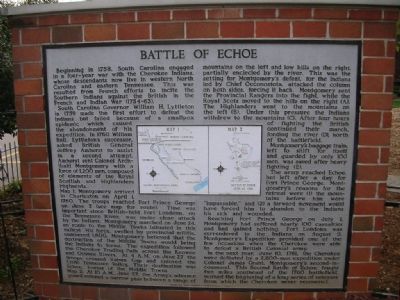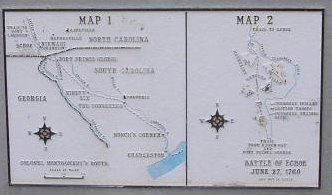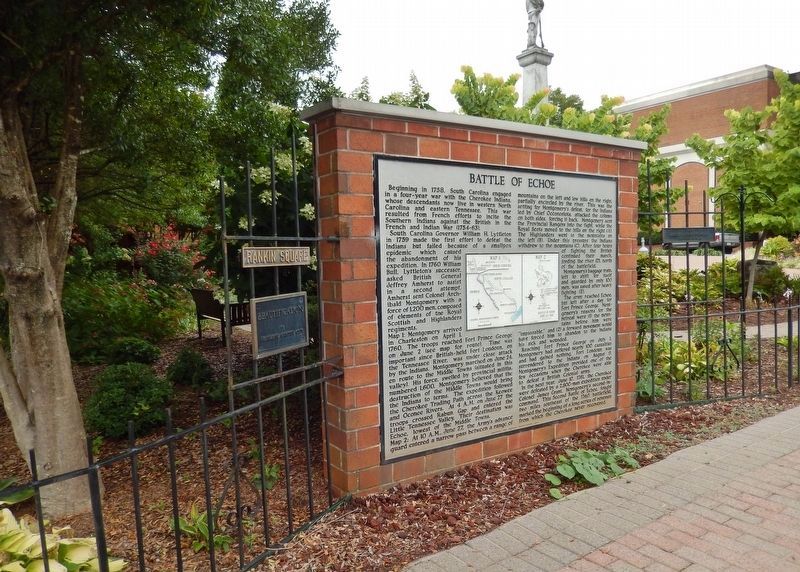Franklin in Macon County, North Carolina — The American South (South Atlantic)
Battle of Echoe
Beginning in 1758, South Carolina engaged in a four-year war with the Cherokee Indians, whose descendants now live in western North Carolina and eastern Tennessee. This war resulted from French efforts to incite the Southern Indians against the British in the French and Indian War (1754-63).
South Carolina Governor William H. Lyttleton in 1759 made the first effort to defeat the Indians but failed because of a smallpox epidemic which caused the abandonment of his expedition. In 1760 William Bull, Lyttleton's successor, asked British General Jeffrey Amherst to assist in a second attempt. Amherst sent Colonel Archibald Montgomery with a force of 1200 men, composed of elements of the Royal Scottish and Highlanders regiments.
Map 1: Montgomery arrived in Charleston on April 1, 1760. The troops reached Fort Prince George on June 2. Time was important since British-held Fort Loundoun, on the Tennessee River, was under close attack by the Indians. Montgomery marched on June 24, en route to the Middle Towns (situated in this valley). His force, swelled by provincial militia, numbered 1600. Montgomery believed that the destruction of the Middle Towns would bring the Indians to terms. The expedition followed the Cherokee Trading Path across the Keowee and Oconee Rivers. At 4am on June 27 the troops crossed Rabun Gap and entered the Little Tennessee Valley. Their destination was Echoe, lowest of the Middle Towns.
Map 2: At 10am June 27, the Army's advance guard entered a narrow pass between a range of mountains on the left and low hills on the right, partially encircled by the river. This was the setting for Montgomery's defeat, for the Indians led by Chief Occonostota, attacked the column on both sides, forcing it back. Montgomery sent the Provincial Rangers into the fight, while the Royal Scots moved to the hills on the right. The Highlanders went to the mountains on the left. Under this pressure the Indians withdrew to the mountains. After four hours of fighting the British continued their march, fording the river north of the battlefield.
Montgomery's baggage train, left to shift for itself and guarded by only 100 men, was saved after heavy fighting.
The army reached Echoe, but left after a day for Fort Prince George. Montgomery's reasons for the retreat were (1) the mountains before him were "impassable," and (2) a forward movement would have forced him to abandon to the Indians his sick and wounded.
Reaching Fort Prince George on July 1, Montgomery had suffered nearly 100 casualties and had gained nothing. Fort Loudoun was surrendered to the Indians on August 9. Montgomery's Expedition provided one of the few occasions when the Cherokee were able to defeat a British colonial army.
In the next year, June 10, 1761, the Cherokee were defeated by a 2800-man expedition under Colonel James Grant, Montgomery's second-in-command. This Second Battle of Echoe, fought two miles southeast of the 1760 battlefield, marked the beginning of a long series of reverses from which the Cherokee never recovered.
Erected 1964 by North Carolina Archives and Highway Departments. (Marker Number QQ-1.)
Topics and series. This historical marker is listed in this topic list: Wars, US Indian. In addition, it is included in the North Carolina Division of Archives and History series list. A significant historical date for this entry is April 1, 1760.
Location. 35° 10.894′ N, 83° 22.87′ W. Marker is in Franklin, North Carolina, in Macon County. Marker is on Phillips Street south of Main Street (Business U.S. 441), on the right when traveling south. Marker is located 1/2 block south of Main Street, on the west side of Phillips Street, at the intersection with Stewart Street. Touch for map. Marker is in this post office area: Franklin NC 28734, United States of America. Touch for directions.
Other nearby markers. At least 8 other markers are within walking distance of this marker. Gem Mining (a few steps from this marker); Macon County Confederate Memorial (a few steps from this marker); Built in 1921 (within shouting distance of this marker); The North Carolina Bartram Trail
(within shouting distance of this marker); Thomas's Legion (within shouting distance of this marker); William Bartram Naturalist (within shouting distance of this marker); Dixie Hall (within shouting distance of this marker); Nikwasi Mound (approx. half a mile away). Touch for a list and map of all markers in Franklin.
Credits. This page was last revised on June 30, 2021. It was originally submitted on November 1, 2007, by Julie Szabo of Oldsmar, Florida. This page has been viewed 2,262 times since then and 101 times this year. Last updated on September 12, 2018, by Cosmos Mariner of Cape Canaveral, Florida. Photos: 1, 2. submitted on November 1, 2007, by Julie Szabo of Oldsmar, Florida. 3. submitted on September 12, 2018, by Cosmos Mariner of Cape Canaveral, Florida. • Bernard Fisher was the editor who published this page.


